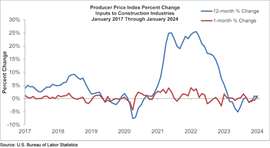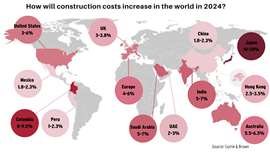‘Uncertainty’ over construction inflation: What price rises do different regions face?
23 February 2024
 Construction activities in many countries are growing. How could that affect costs? (Image: Adobe Stock)
Construction activities in many countries are growing. How could that affect costs? (Image: Adobe Stock)
Mitchell Keller explores a new report from UK-based cost consultant Currie & Brown, combined with the latest US price data, to see what 2024 has in store for construction inflation across the globe.
If the movement of construction input prices over the past couple of years has been difficult to predict, then it is unlikely to be much easier in 2024.
In fact, the word that best sums up the outlook is “uncertainty” according to a new report from UK cost consultant and project manager Currie & Brown.
Last week saw the release of Currie & Brown’s new report How to Navigate 2024: Balancing Challenge with Opportunity, which forecasts construction prices and how they are likely to differ across different regions of the world.
The report found that global construction costs rose 3.64% in 2023. That was set against a backdrop of continued volatility, with prices rising 21% in the five years to 2023.
“Across markets, [uncertainty] is coming from every direction. We are seeing significant geopolitical turmoil and stubborn inflation, acute skills and materials shortages and tightening sustainability regulation. These factors – and many more – are driving up construction costs globally,” said Currie & Brown CEO Alan Manuel.
Here’s how the report forecast 2024 construction price inflation in different key markets across the globe:
USA to see 3-6% price inflation
Following a stronger-than-expected 2023, the USA is poised for more steady construction activity, Currie & Brown forecast, predicting price growth in the range of 3%-6%.
“Data centres, manufacturing, and semiconductor facilities are driving growth. Subsidies from the CHIPS Act and Inflation Reduction Act have added fuel to already strong construction activity in the semiconductor, battery, and electric vehicle (EV) manufacturing sub-sectors,” says the report.
Though a skilled labour shortage in the US – as well as the uncertainty of a presidential election – could drive prices up even further should projects become too abundant or move too quickly.
 ABC’s Producer Price Index percentage change of inputs in the construction industry from January 2017 through January 2024. (Image: ABC)
ABC’s Producer Price Index percentage change of inputs in the construction industry from January 2017 through January 2024. (Image: ABC)
“These high-demand sectors are putting added pressure on labour and resource shortages, particularly for mechanical, electrical, and plumbing trades, which is driving up costs,” says Currie & Brown.
Although still early in the year, new data released by Associated Builders and Contractors (ABC) in its monthly construction input prices report appeared to bear that out. It said in-country input prices “surged” 1% in January 2024 compared to the month prior.
The figures come from ABC’s analysis of US Bureau of Labor Statistics’ Producer Price Index data released on 16 February.
“Construction materials prices surged in January, ending a streak of three consecutive monthly declines,” confirmed ABC chief economist Anirban Basu.
Prices also rose in two of three energy subcategories last month, said ABC, noting crude petroleum input prices were up 6.1%, while unprocessed energy materials prices were up 3.8%.
It’s an increase over the short-term, but Basu noted 2024’s early prices are not drastically dissimilar to last year’s figures during the same period. Overall construction input prices, according to ABC, are 0.4% higher than one year ago, while non-residential construction materials prices are 0.7% higher.
“While [the 1% surge] represents the largest monthly increase since August 2023, input prices are essentially unchanged over the past year, up less than half a percentage point,” said Basu.

Even though the first month of the year started with an input prices surge, Basu pointed to the ABC Construction Confidence Index as a sign that US builders and contractors still expect a productive first half of the year.
“As a result of relatively tame input costs, a plurality of contractors expects their profit margins to expand over the next six months,” said Basu.
One consequence of the confidence, though, is the US Federal Reserve may delay anticipated interest rate drops, which may keep borrowing rates higher for longer than firms had hoped.
UK to see 3% to 3.8% construction costs increase in 2024
Citing this year’s general election, high interest rates, and inflation, the Currie & Brown report forecast construction costs in the UK to rise as much as 3.8% this year.
“We expect residential and private commercial construction to remain subdued until interest rates fall,” states the report. “Falling property prices, a lack of skilled workers, expensive materials, sustainability compliance and sluggish productivity all present challenges to the market. New builds will take a back seat to refurbishments as the net-zero agenda progresses.”
Currie & Brown went on to say that UK firms will need to manage demand for labourers and materials while complying with carbon reduction and safety legislation. The firm suggested adopting advanced digital technologies to stay ahead of the curve.
Europe will see building cost escalation as high as 6%
While the UK was estimated in a tight range, the rest of Europe is expected to see construction costs rise 4% to 6% this year, according to Currie & Brown.
“Strong labour markets, combined with low unemployment rates and rising wages, are creating a challenging environment,” states the report. “This puts pressure on labour costs. From a rate of almost 9% in 2023, declining energy prices and stabilised material supply chains will curb cost increases in 2024 to around 4-6%.”
Data centre projects are anticipated to see some of the largest annual growth numbers, bringing both positives and negatives, Currie & Brown’s report said.
“The increase in demand is also driving scarcity of resources and experienced contractors,” stated the report. “Organisations will need to diversify supply chains and materials options to mitigate this challenge and keep their projects on track and to budget.”
Saudi Arabia likely to see 5% to 7% rise on construction costs
Currie & Brown’s report expects lower-end price hikes (2-3%) for the United Arab Emirates (UAE) but anticipates both major growth in the Kingdom of Saudi Arabia along with increasing costs.
“Saudi Arabia’s Vision 2030 and megaproject pipeline continues to buoy its construction industry,” stated Currie & Brown. “We foresee that residential, renewable energy, data centre, infrastructure, and hospitality construction will grow. The full impact of the 2034 FIFA World Cup remains to be seen once the official announcement is made. There is significant competition to attract and retain competent labour, consultants, and contractors. This will contribute to cost increases of 5-7% per year for the next two years.”
The UAE, too, is slated for huge growth, but the report suggests that construction costs won’t escalate along with it.
“A budget surplus due to high oil prices will provide opportunities in the UAE for social and infrastructure development,” said Currie & Brown. “We expect activity to grow by 3.9% per year from 2024 to 2027, fuelled by the country’s population boom.”
China slowdown continues, Japan costs swelling, ‘India will grow’
Perhaps the most confident statement in the report comes in relation to India, which has seen a construction activity renaissance the last decade. The next decade, too, could be even more productive than the last amid increased government investment in infrastructure, urbanisation, and real estate, along with data centre and semiconductor growth.
All in all, India’s construction costs are in-line with expectations for the rest of the world; the report estimates an increase by 5-7% in 2024, “driven by evolving regulations, skilled labour shortages and the need to comply with environmental standards.”
In Japan, some of the largest increases to construction costs across the world are expected in 2024.
“Large projects have been adding pressure on competition for resources in Japan,” explained Currie & Brown, “resulting in cost surges of 30-40% over the past two years.”
Increasing high-tech construction projects in-country, as well as a weak Yen, suggest that more escalation is in store. Currie & Brown predicted a 10-20% rise in construction costs in Japan for 2024.
“This is due to delays on imported materials and long lead times on major equipment,” says the report. “New labour regulations (from April) limiting overtime may add fuel to the fire.”
China’s industry-leading pace and volume showed signs of slowing last year, and the report suggested more of a plateau for 2024.
Construction cost increases, however, should be below the global average.
“The construction industry in China faced challenges in 2023 with developer liquidity issues and nervous investors,” said the report, adding “the market will continue to falter, but with pockets of growth in infrastructure, electric vehicles, and high-tech construction.”
Australia expected to see up to 6.5% construction cost hike
Australia’s construction activity pace dipped down in recent years, and Currie & Brown anticipate more of the same in 2024. Parallel to high interest rates and a ‘severe’ lack of skilled labour, the report expects as much as a 6.5% increase to construction costs this year, despite the mild pullback.
“We expect that high interest rates will lead to construction activity weakening slightly,” stated Currie & Brown. “Despite a potential slowdown and subdued market (with industry feedback indicating building value approvals fell over the last 12 months), we predict that construction costs will increase 5.5-6.5% in 2024.”
To read Currie & Brown’s full report, click here.
Brought To You By
|
STAY CONNECTED



Receive the information you need when you need it through our world-leading magazines, newsletters and daily briefings.
CONNECT WITH THE TEAM








